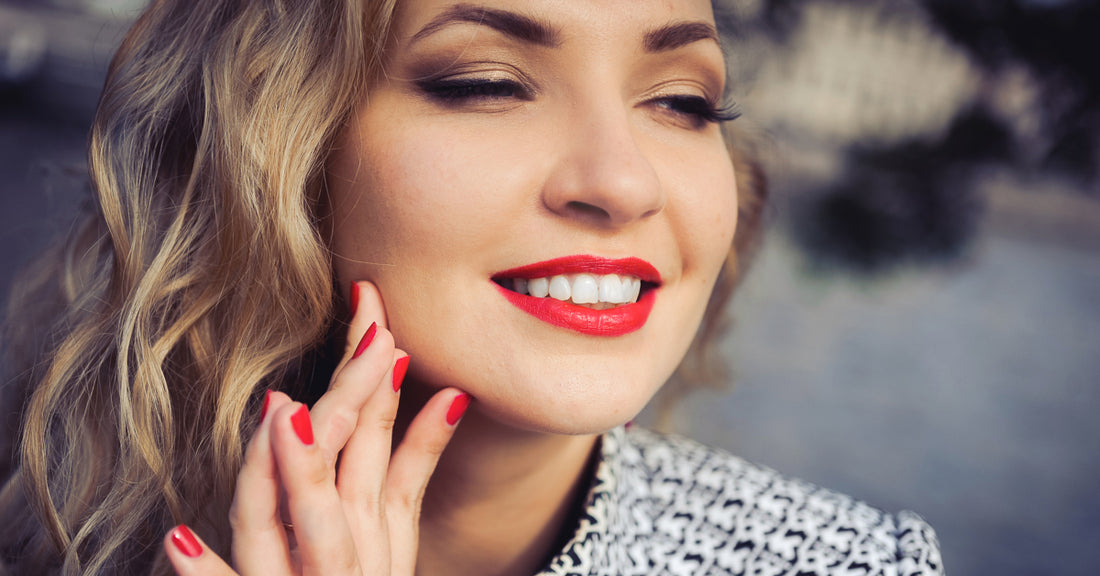What is nail biting?
Do you find yourself biting your nails when you are stressed, tired, bored or anxious? Nail biting is not uncommon - and it’s not always just a “bad habit.” Like a bad habit, nail biting is an unwanted pattern of behavior - it’s something you don’t want to be doing. But, nail biting becomes more than just a bad habit when it moves past being a harmless physical action and becomes a medical condition that impacts your quality of life socially, physically and emotionally.
Going from a “bad habit” to impacting my social, physical and emotional well-being is what happened to me - and what has happened to millions others like me - as 20-30% of the U.S. live with chronic nail biting.
Chronic nail biting is medically known as the mental health condition onychophagia. Onychophagia is part of a group of conditions called Body Focused Repetitive Behaviors (BFRBs). BFRBs also include compulsive hair pulling (trichotillomania), excessive skin picking (dermatillomania) and other repetitive self-grooming behaviors that are often subconscious and uncontrollable. Even though BFRBs are self-soothing mechanisms, these behaviors still tend to cause damage to both body (hair, skin, nails) and mind.
My nail biting was life threatening.
When I was 7 years old, I started pulling my eyelashes. (l later learned this is called compulsive hair pulling, or trichotillomania). At 7, I had no idea why I was doing this. My parents too had no clue that it was a medical condition. They were just as confused as I was and sadly, thought something was “wrong” with me because I had this undesirable behavior. Though they understand I wasn’t aware of my eyelash pulling in the moment, they didn’t understand that it could potentially lead to social issues down the road.
I don’t blame them as it was the late 80s and they didn’t have access to the information we now have at our fingertips. They did the best they could. They talked to my teachers and explained the eyelash hair pulling behavior. They also would give me stuffed animals to play with and keep my hands busy. They never said what I was doing was “bad” and they never punished me for it. They just tried helping me replace the eyelash pulling with something else. And it worked...until it didn’t. I was able to stop pulling my hair, but instead my behavior quickly shifted to nail biting. I was just following orders rather than trying to change the behavior on my own.
My parents weren’t thrilled about it, but to them nail biting was a “lesser evil.” They felt that because a lot of people bite their nails it was less socially ostracizing. And that was that. I can’t blame myself or my parents because it was an issue more complex than we realized back in the 80s. If my parents knew how to support my BFRB recovery, things might have been different but it wasn't available back then.

I continued biting my nails for nearly 20 more years because there was no more intervention or interfering from my parents. As a kid, I wasn’t taught the skills needed to be aware of the nail biting, nor the skills to replace the unwanted nail biting. So my nail biting went from something casual and socially acceptable to something unchecked. I struggled to hide. As I got older, my nail biting got harder and harder to control to the point of getting infections in my fingers, near my cuticles.
As a kid with a BFRB, I felt really alone and tried to hide it as much as possible for fear of being made fun of or judged. I stopped hanging out with friends because it was easier to do that than to explain why I had so many bandaids on my nails. I remember one time in middle school, my dad pulled up the driveway to a friend’s house to drop me off at her birthday party. I got last-minute jitters and ducked down in the backseat, crying and begging him to take me home — I didn’t want to be caught.
My nail biting wasn’t killing me in the physical, but I felt like I was dying inside.
Growing up with this seemingly harmless nail biting “habit” meant constantly worrying my bandaids would fall off or someone would be grossed out at the damage I was doing to my cuticles and fingertips. The scars were permanent reminders that not only fed my internal guilt and ate away at my self-esteem, but also gave middle school bullies a reason to have their fun.
It was hard feeling like no one understood my struggle. When people don’t understand why I couldn’t “just stop” nail-biting behavior, they are showing their judgment against people like me. This lack of compassion and understanding led to stares, whispers and jeers.
It is isolating and strengthened the narrative in my mind that there was something wrong with me.
All of which made it feel like life was over.
The stress my nail biting caused, the physical marks it left and the mental anguish of going outside “looking like that” all made daily living a chore. Compulsive nail biting, just like hair pulling and skin picking are trance-like. For those of us with these BFRBs, we aren’t able to live and enjoy life because our time is spent locked in a bathroom fixing a wig or makeup to cover it up. If not locked in a bathroom, we are locked in our own heads — trying to convince ourselves no one will notice and that we should just go out to that party we were invited to — only to finally give in to our BFRB and sit at home.
And so we miss out on life’s key moments with friends and family, losing out on the opportunity to share in laughter, joy and life.
How to stop biting nails permanently
When I turned 25 I began to look inward at the “why” behind my nail biting and realized it was my body’s way of easing my stress and anxiety. With access to the internet I was able to learn more about my nail biting condition and found community. I was not alone anymore.
It was incredibly hard to stop nail biting on my own because it wasn’t something I realized was happening. I tried a lot of things to stop nail biting - from funny looking thumb guards to that nasty tasting nail polish. None of it helped because it wasn’t helping me understand and deal with the urge.
Then a year ago, I found HabitAware Keen, a smart bracelet that was invented by a woman with compulsive hair pulling disorder to help people like me stop nail biting, skin picking and hair pulling. I watched her TEDx video about it and was really fascinated by this habit-tracking bracelet and the methodology to stop my nail biting.
-
Build Awareness of Nail Biting

The premise of this sleek wearable is simple - I connected Keen to the mobile app and “trained” it for my nail biting movements. Then, the bracelet recognized when I was biting my nails and vibrated. The goal of the vibration was to help me build awareness of this trancelike behavior. The vibration was a gentle “hug” on the wrist and a discreet reminder that my hands weren’t where I wanted them to be. This step is about simply being aware and noticing the behavior is happening, in a non-judgemental way.
-
Reflect on the Triggers Behind the Nail Biting

With awareness, I was able to then assess what was really triggering the nail biting by thinking about what I was feeling and doing in the moment. The vibration is a cue to change the conversation in my mind away from the act of nail biting to the thoughts & feelings motivating the action.
-
Replace the Nail Biting

My nail biting served a purpose - to help me self soothe when I was stressed. Understanding this trigger behind the urge helped me find healthier ways to soothe the urge. Recognizing when I was nail biting, where I was nail biting and why I was nail biting offered clues to how I could better satisfy the need behind the urge by changing things around in my apartment, or while I was driving so I wouldn’t get the urge to bite my nails. In finding that stress and anxiety were major triggers, I started setting aside 5 minutes in the morning to do deep breathing and start my day right. I also take walks in between studying and keep a giant bottle of water to stay hydrated. In class, I kept little toys to fidget with and keep my hands busy. In these ways I was able to not just stop nail biting but embrace healthier behaviors that are positively impacting my life!
Habit Reversal Training. The Science Behind How to Stop Biting Your Nails
What we’ve discovered is the same principles that helped Annabelle overcome nail biting through HabitAware are the fundamental aspects of the gold standard of BFRB treatment, Habit Reversal Training.
Awareness Training
The foundation of HRT is developing awareness of the habit you want to change. For nail biting, this involves identifying when, where, and why you engage in the behavior. By understanding the triggers and patterns associated with nail biting, you can gain better control over the habit.
Competing Response
The core concept of HRT is to replace the undesirable habit with a "competing response" that is incompatible with the targeted behavior. For me it was keeping my hands busy or going for walks.
Behavioral Analysis and Modification
HRT emphasizes a thorough analysis of the antecedents (triggers) and consequences of the habit. Understanding the factors that lead to nail biting and the outcomes of the behavior allows for the development of a personalized plan.
HabitAware Keen helped me stop nail biting

HabitAware is more than a company - knowing that the founder lived through a similar condition gave me hope that I too could stop nail biting. I feel great knowing I am part of a community actively doing the work to make positive self change...and greater still knowing that “stopping” isn’t the end all be all and that’s it’s ok to slip every now and then. I’m in a much healthier mentality and have much healthier nails now too!
Here’s what other people had to say about using the HabitAware Keen bracelet to stop nail biting:
Keen has “been totally worth it. The bands have been an immeasurable help...even if I don't wear the bands, I am much more aware...I continue to not bite my nails...I am going to have to trim my nails soon, which is something I haven't done in 20+ years."
~ Eric B.
“I haven’t bitten my nails since I started using Keen. A 70-year habit doesn’t change in a month. Keen has been very helpful..Just putting it on reinforces what I am working on.”
~ Dina L.
“My son is 12 and wears (Keen) to help him kick his nail biting. So far, the HabitAware Keen has done really well to let him know when he's biting and give him the choice to stop...I love this product and I do recommend it to others.”
~ Jess D


